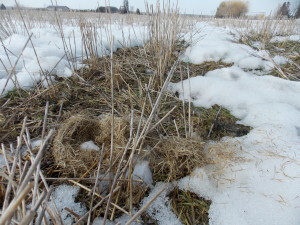In late April, when the snow finally receded (I didn’t think spring would ever get here), I decided to take a walk through my field that was winter wheat last year. As you may recall from a previous post, last year I harvested winter wheat and followed that with planting a radish cover crop. The radish cover had agronomic purposes which included retaining nutrients, alleviating soil compaction, and providing residue to suppress weeds. The combination of standing wheat residue and growing radish cover crop produced a migratory waterfowl paradise on their journey south.
Walking through that field on a cool spring day a few weeks back, I became surprised by even more evidence of wildlife taking advantage of the winter wheat residue and radish cover crop. In just a few acres, I found 3 nests.
These nests were likely built by meadowlarks or dickcissels, which depend on grasslands as their primary habitat. It was evident that the nests were built after wheat harvest in mid-August; the nests were, after all, constructed with the chopped wheat straw. It was also evident the nests were built before the snow, as some were still partially covered by the winter’s blanket.
Proven Results
We already know about the water quality and carbon sequestration benefits of cover crops. Research has shown that cover crops can reduce field nutrient runoff by up to 90% and that cover crops are a key ingredient to maximizing carbon sequestration, an important step to addressing climate change. However, one area lacking a solid body of knowledge is the direct nesting and foraging benefits of cover crops. Established research has shown that no till provides a significant wildlife benefit in terms of nesting and foraging for bird species.
The evidence emerging from the winter lull provides further proof of the wildlife benefits of no till and cover crops. One may ask: how do cover crops provide benefits to wildlife? The answer is threefold.
- First, cover crops provide residue for nesting and protection from predators. In order to maximize this value to wildlife, covers need to reach at least 16 inches in height and contain a mixture of species.
- Second, cover crop residue provides direct foraging sources for a number of species. Grasses and clovers are popular food sources for many bird species.
- Third, cover crops improve soil health and encourage populations of soil micro and macro organisms. These soil organisms, from mites to earthworms and everything in between, form the basis for the animal food web.
Now by no means did I conduct a full scientific experiment in my field with replicated plots of control and variable. However, it does provide further real farm evidence of the wildlife value of adding cover crops to working lands. Last year, National Wildlife Federation provided funding to a few research projects to scientifically examine the impact cover crops have on wildlife, from amphibians to birds. Results from that first year of research will be released in early 2015, so stay tuned for that information.
The post Evidence Builds: No Till and Cover Crops Make Working Lands More Wildlife-Friendly appeared first on The National Wildlife Federation Blog.






